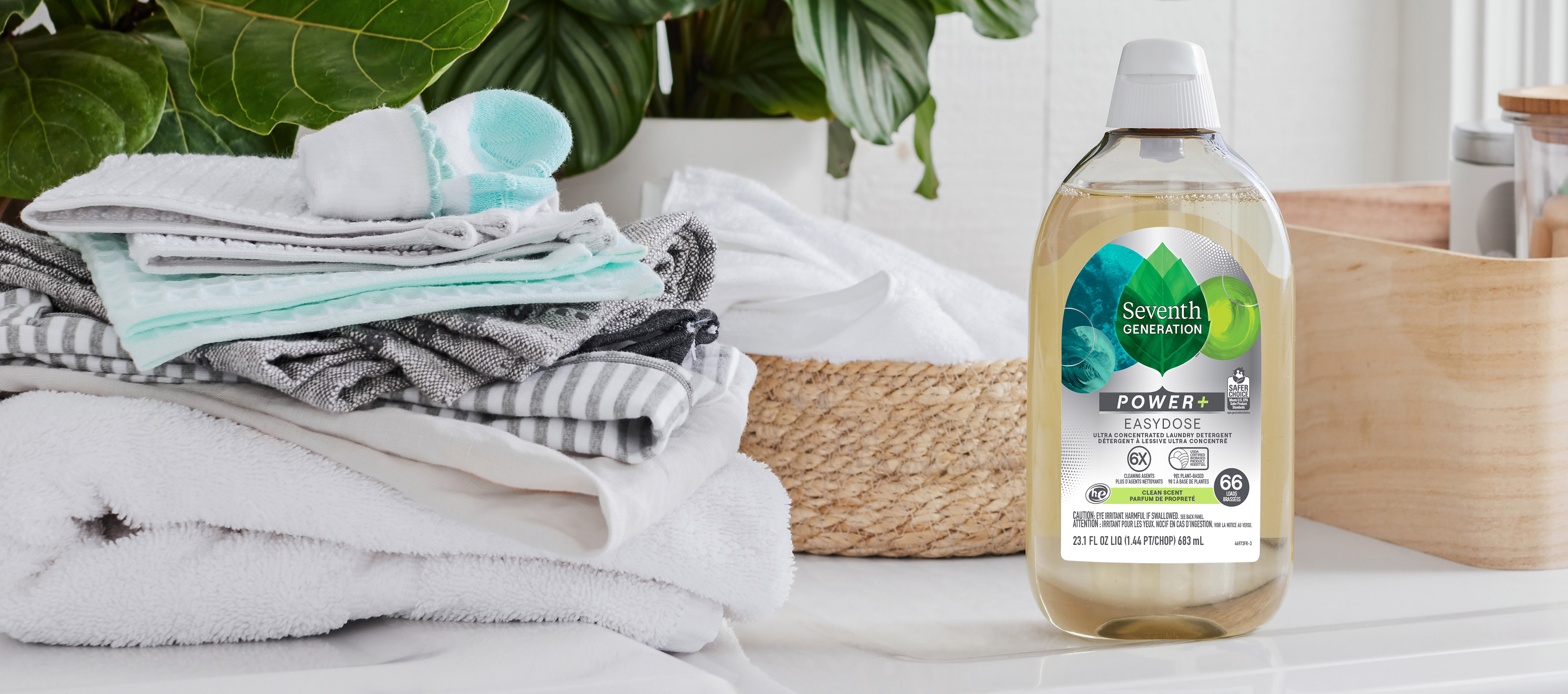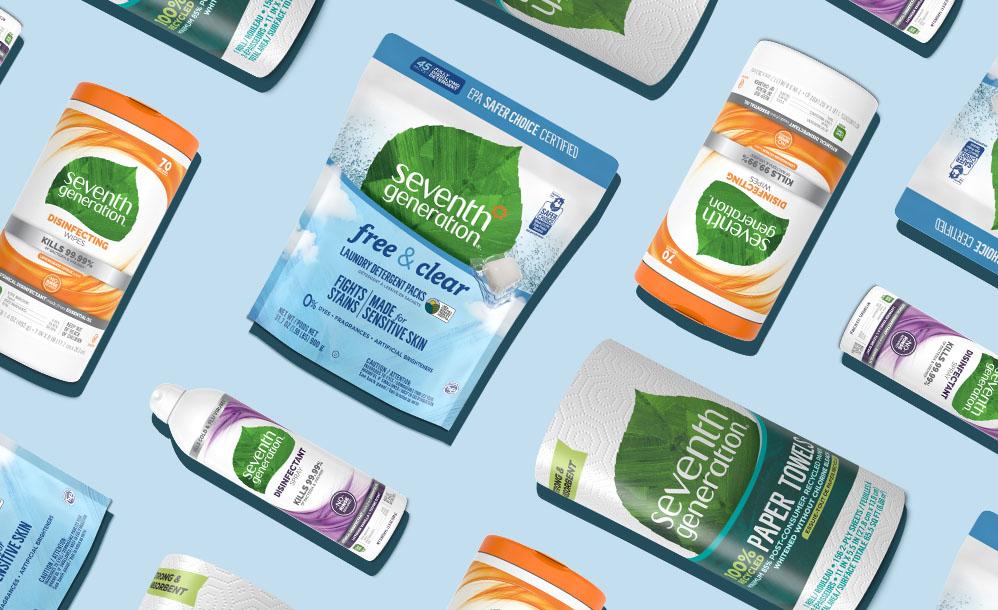Clean doesn’t have an overpowering smell that lingers in your closet for months. Clean doesn’t have to include optical brighteners that leave clothes appearing whiter than they truly are. Clean can come from powerful, plant-based ingredients while kicking those tough messes to the curb.
At Seventh Generation, we’ve worked hard to develop a range of plant-powered laundry products to meet your home and families’ needs. Our stain-fighting liquid laundry formulas are tested on 60 real-life stains to get the job done and are made with renewable, plant-based ingredients instead of petroleum-based ingredients so they help lessen our impact on the planet. A win-win!
Our all-inclusive stain-removal guide has you covered for whatever messes come your way.
- Don’t Wait: Reacting to stains quickly before they set is always a good idea.
- Pre-Treat: An enzyme-powered Stain Remover gets the jump on blemishes and lets you come back to them when you have time, which is usually later.
- When in Doubt, Soak: If you can’t pre-treat, soaking stained garments in cold water is a good first step.
- Air Dry: Dryer heat can set smudges, so try to air-dry clothes when removing.
Summer: Nothing beats throwing open the windows and getting outside after a long winter. Unfortunately, all that extra activity can make summer one of the stainiest times of the year.
- Grass, Mud, and Sweat: Pre-treat these tough stains with stain remover before washing in cold water with a biobased detergent and air drying.
- For persistent grass stains, make a solution of 2 parts vinegar to 1-part water, and gently scrub with an old toothbrush.
- Organic Stains: Blood stains from skinned knees are a summer stain all parents know well. Pour hydrogen peroxide directly onto blood stains and blot with a clean rag. You can also try our color-safe chlorine-free bleach. [1]
- Stinky Stains: Take the stink out of summer stains with a vinegar and water mixture.
- Be Ready: Members of our Generation Good Community suggest keeping a cold water “stain bucket” around during summer. Drop clothes in at the first sign of a discoloration, which will help keep the stain from setting—and buy you some time.
You can explore our full guide to fighting summer stains here.
Winter: Winter not only increases laundry duties, it comes with its fair share of stains. Here are some tips to help you stay ahead of winter messes.
- Slush and Mud: Though it’s tempting to wait, slush and mud stains are harder to remove once they’re set, so pre-treat with stain remover, and wash in cold water ASAP.
- Salt stains: Fight back against salt rings by blending equal parts white vinegar and water and dabbing at the affected area until clean.
Insider Tip: After getting the salt specks off your boots, stuff some balled-up newspaper into the feet to absorb moisture and odor. Once dry, sprinkle in some baking soda to further absorb odors and freshen up your boots.
Since we end up doing more laundry in the winter, we love using our new EasyDose ultra concentrated detergent. The new compact bottle is 100% post-consumer recycled plastic and uses 60% less plastic, 50% less water, and is 75% lighter than our 100oz laundry detergent.
Many of life’s toughest stains come from food spills, drips, and splatters. Our Ultra Power Plus detergent is tested on tough food stains, and is color safe. And it’s still made from renewable, biobased ingredients for a clean you can feel good about.
- Greasy or Acidic Stains (oil, tomato sauce, chocolate): dab these stains with a gentle dish soap, which will help lift the blemish before it gets too comfortable. For tough grease stains, first cover the mark with baking soda to help absorb some of the grease.
- Fruits, Vegetables, Juice, Coffee: Soak these stains with vinegar before washing.
- Red Wine: Rinse red wine stains under cold water right away (if possible). If the stain won’t budge, saturate it with a mixture of 1-part dish soap and 3-parts hydrogen peroxide, then blot with a clean white rag.
- Insider Tip: For extra-persistent wine stains, stretch the fabric tightly over a bowl, cover the splatter with salt, and slowly pour boiling water over.
New baby = new messes. Choose a fragrance-free detergent made with renewable ingredients that’s designed to be gentle on baby’s sensitive skin, but tough on baby stains.
- Breast Milk: Breast milk can make a mess of clothes, so it’s a good idea to be prepared. Rinse the garment in cold water and scrape away any dried-on milk. Then, spritz with stain remover and wash in cold-water.
- Insider tip: Don’t use bleach on breast-milk stains as the proteins in the milk can leave a brown stain.
- Diaper Disasters: For solids, scrape any excess waste into the toilet, then rinse with cold water and apply stain spray. For extra tough stains, use some lemon juice to increase your stain-fighting power.
- Insider Tip: Try to get these messes into the wash before the stain dries, or soak in cold water until you can.
- Insider Tip: Bright sunshine has long been considered a remedy for yellowish, blow-out stains. So, consider drying those fresh washed onesies in the bright sun.
- Fruit Purees and Juices: Rinse fruit splotches under cold water, then dab with a mixture of 1 part dish liquid and 3 parts hydrogen peroxide.
For when life, and accidents, happen.
- Ink stains: Did your toddler turn your new shirt into a canvas? Don’t fear. Mix a paste of equal parts lemon juice and cream of tartar, then smear the paste on the stain and let it sit for several hours. Then, brush off the paste and wash in cold water. Voila!
- Sticker gunk, gum, wax: Give sticky messes the cold shoulder—literally. Press ice against the sticky surface until it hardens, or even put the garment in the freezer. Then, scrape off as much as you can with a dull knife before treating with stain spray and washing.



